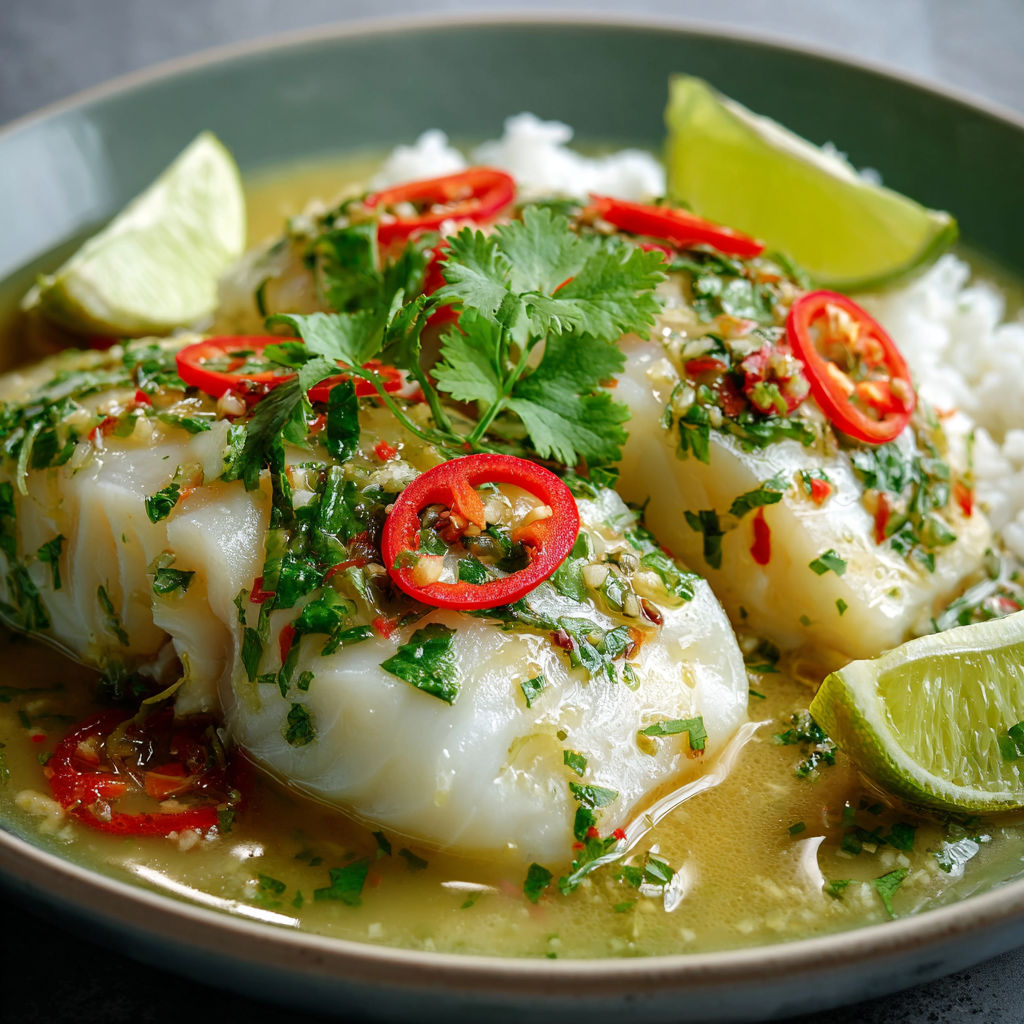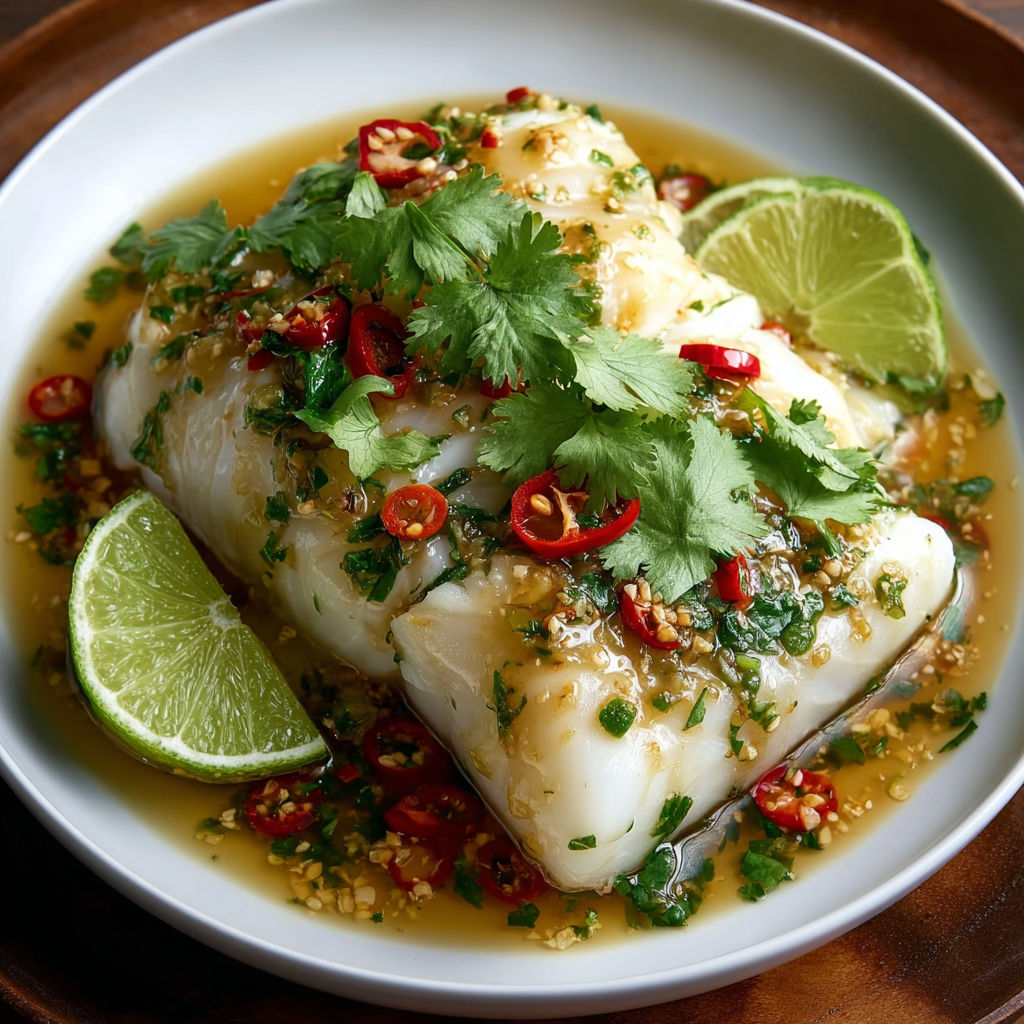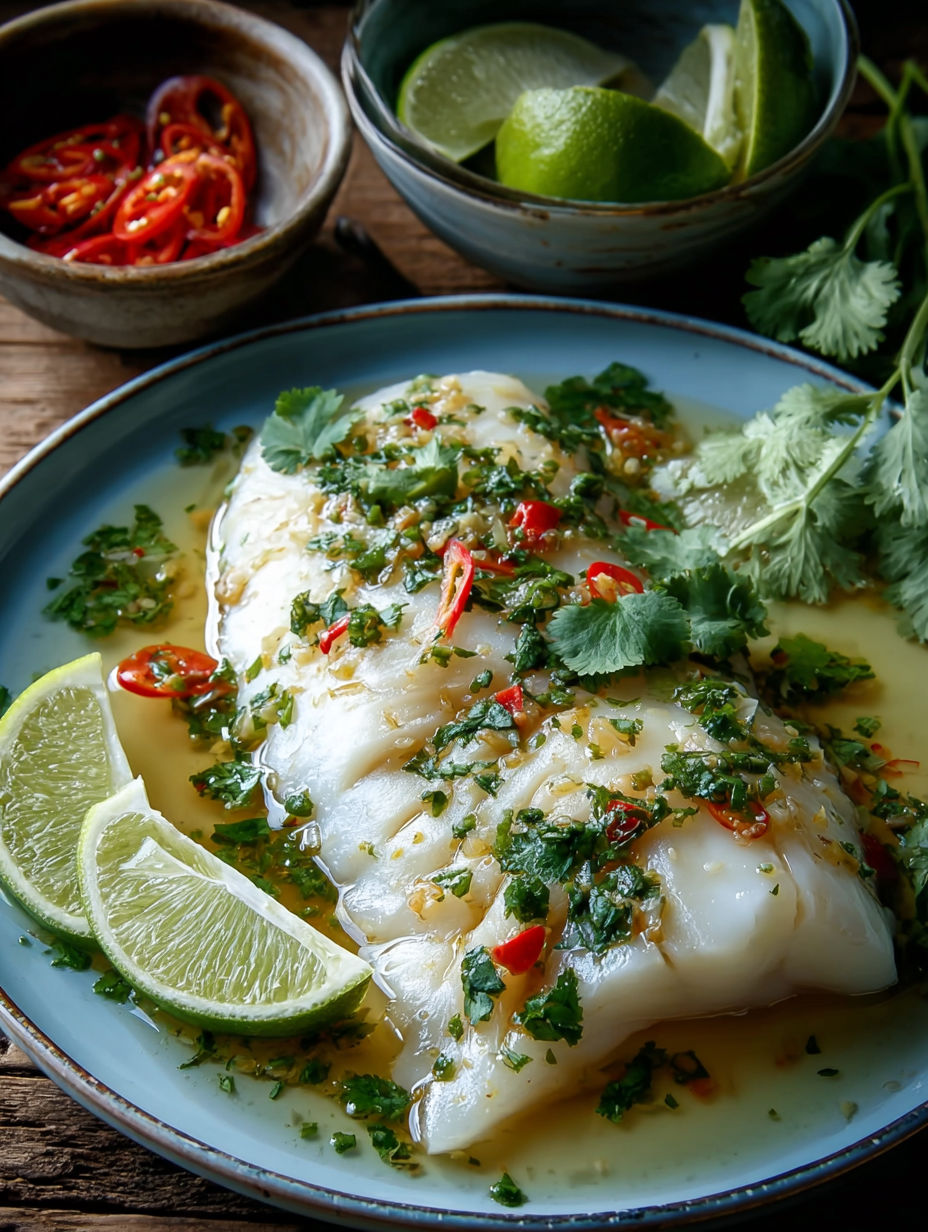 Pin it
Pin it
This delicate Thai Lime-Garlic Steamed Fish with Coconut Lemongrass Sauce turns ordinary fish into an amazing homemade dish that brings real Thai tastes right to your table. The gentle steaming keeps all the moisture locked in while loading the fish with zesty citrus and rich flavors.
I first tried making this after coming home from Thailand where I totally fell for their seafood cooking. Whenever I taste that mix of lime, garlic and lemongrass, I'm instantly back at those little restaurants by the ocean.
- Fish fillets: like tilapia, bass or cod picked for their subtle taste that soaks up all the fragrant marinade
- Fresh lime juice: gives that key tanginess that cuts through the creamy coconut sauce
- Fish sauce: drops in that true savory kick that makes Thai food special - grab a good one without extras
- Lemongrass: adds that special lemony scent nothing else can match - try to get fresh stalks
- Coconut milk: makes the smooth sauce base - go with the full-fat kind for best results
- Fresh cilantro: throws in that last herby touch that pulls everything together
- Red chili: brings as much or little spice as you want - tweak it to suit your taste buds
How To Cook Flavorful Thai Lime-Garlic Steamed Fish
- Mix up the marinade:
- Combine crushed garlic, fresh lime juice, fish sauce, soy sauce and sugar in a little bowl. The sour stuff helps soften the fish while garlic flavors sink in during cooking. Mix well until the sugar dissolves, which helps balance the salty and tangy parts.
- Get your steamer ready:
- Add about two inches of water to a pot and heat until bubbling gently. Put your steamer basket above the water making sure it doesn't touch. This soft cooking way keeps the fish nice and tender.
- Soak and position the fish:
- Put your fish pieces on a heat-safe plate that fits in your steamer. Drizzle the garlic lime mix all over, letting some gather around the sides. Wait 5 minutes before steaming so it soaks up plenty of flavor.
- Steam until just right:
- Close the steamer tight and cook for 10-12 minutes. You'll know it's done when it turns white and breaks apart easily when you press it with a fork. Don't cook too long or it'll get tough and dry.
- Make your coconut sauce:
- While the fish cooks, mix coconut milk, bruised lemongrass, ginger and the other sauce stuff in a pan. Let it bubble softly for about 10 minutes, stirring now and then so it doesn't burn. The sauce should get a bit thicker but still be easy to pour.
- Put it all together:
- Move the cooked fish to plates carefully so it stays in one piece. Pour the coconut lemongrass sauce all over the fish, letting it fill the plate. Top with fresh cilantro and lime slices for extra zing.
Lemongrass is hands down my favorite thing in this dish. I actually grow it in containers on my porch just to have it ready for Thai cooking. The best time I made this was during a little cooking party with friends who'd never tried real Thai food beyond the usual noodles. Their faces when they tasted all these clean but complex flavors was so worth it.
Storing and Planning Ahead
The fish tastes best right after you cook it but you can fix the coconut lemongrass sauce up to 3 days early. Just keep the sauce in a sealed container in the fridge. When you want to use it, warm it slowly on the stove until just heated through. If it separates in the cold, just stir it while heating and it'll come back together.
Swapping Ingredients
Can't find fresh lemongrass? Use 1 tablespoon of lemongrass paste from the grocery store produce area instead. Want something lighter? Try light coconut milk instead of full-fat, though your sauce won't be as thick. Some lime zest can boost the citrus taste if your limes aren't very juicy. Don't eat meat? This marinade and sauce works great with firm tofu or chunky veggies like cauliflower slices.
 Pin it
Pin it
Food Tradition Background
This way of cooking shows how Thai food tries to balance five main tastes - sweet, sour, salty, spicy and bitter. Steaming fish is something people all over Southeast Asia do because it keeps the natural taste and goodness of seafood. In Thailand, folks would usually serve this family-style with a big bowl of jasmine rice and maybe some quick-cooked veggies on the side. You'll find coconut milk and lemongrass used a lot in southern Thai cooking where they eat tons of seafood every day.
 Pin it
Pin it
Frequently Asked Questions
- → Which fish works best for this meal?
White fish fillets like tilapia, snapper, cod, sea bass, or barramundi are great choices. Use fresh, evenly thick fillets (about 1 inch) to cook through evenly. Firmer types hold their shape better while steaming.
- → How can I make it less spicy?
Sure thing! Skip the red chilies or just use fewer and take out the seeds. You’ll still get that fragrant lime, garlic, and lemongrass punch without the heat stealing the show.
- → What can I use instead of lemongrass?
If fresh lemongrass is hard to find, try 2-3 tablespoons of lemongrass paste or blend 1 tablespoon of lemon zest with 1/2 teaspoon of grated ginger. These swaps keep it bright and citrusy even if not exact.
- → What are good sides to serve with this fish?
Jasmine rice or creamy coconut rice are perfect for soaking up the sauce. Steamed greens like bok choy or a fresh tangy cucumber salad would make a great pairing. A green mango salad could also give a sweet and sour pop.
- → Can I prep anything in advance?
You bet! The coconut lemongrass sauce can be made ahead by up to 2 days and stored in the fridge. Gently heat it when needed. Mix the lime-garlic marinade a few hours ahead, but only marinate the fish right before cooking for the best flavor and texture.
- → What if I don’t have a steamer?
Make your own by placing a heat-safe plate over an upside-down bowl inside a large pot with a bit of water at the bottom. Keep the water level below the plate, cover tightly, and steam away. Another option is wrapping the fish in foil or parchment and baking at 375°F (190°C) for about 15 minutes.
